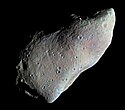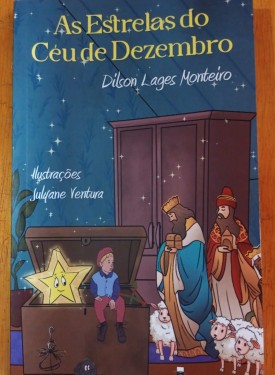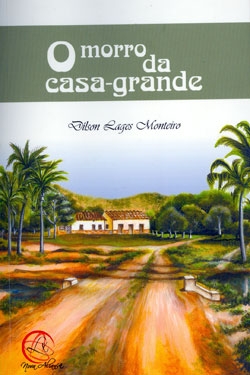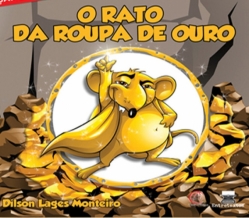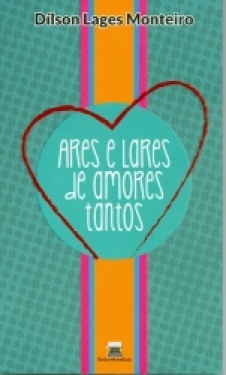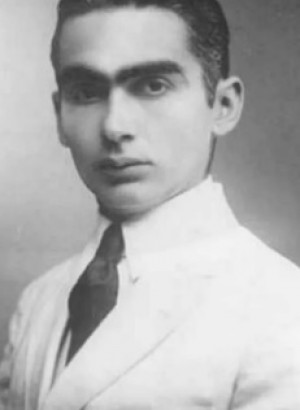O asteróide Itokawa lembra um amendoim com casca
Já chegaram à Terra suas amostras, espetacularmente colhidas que foram pelos japoneses.

(http://ganjinbr.blogspot.com/2008_06_01_archive.html)
 (http://projetomaringa.blogspot.com/2008_06_01_archive.html)
(http://projetomaringa.blogspot.com/2008_06_01_archive.html)

(http://projetomaringa.blogspot.com/2008_05_01_archive.html)

O PRINCIPE JAPONÊS NARUHITO, QUE DEMONSTRA
GRANDE ALEGRIA POR ESTAR VISITANDO O BRASIL,
FOTOGRAFA, APESAR DO TEMPO NUBLADO,
A CIDADE MARAVILHOSA, o RIO: ao fundo, a Enseada
de Botafogo, com a estátua do Cristo Redentor - uma
das sete novas maravilhas do mundo - encoberto
(http://informativorio.blogspot.com/2008_06_01_archive.html
onde se pode ler:
"O príncipe herdeiro do Japão, Naruhito, aproveitou a terça-feira (24 [de junho de 2008]) para visitar o Pão de Açúcar, na Zona Sul do Rio. Apesar do tempo nublado, o príncipe não negou sua cultura e pediu uma câmera fotográfica para registrar o ponto turístico. Mas, por causa das nuvens, não conseguiu enquadrar o Cristo Redentor. Naruhito quebrou o protocolo e conversou com jornalistas japoneses, dizendo que gostou do que viu. A visita durou cerca de uma hora.
(G1.com.br)")

O PRÍNCIPE NARUHITO, historiador com doutorado em Humanidades, SUA SENHORA, A PRINCESA CONSORTE DO JAPÃO MASAKO OWADA, ex-diplomata, E SUA LINDA E INTELIGENTE FILHA, SUA ALTEZA IMPERIAL PRINCESA AIKO, cujo título oficial é PRINCESA TOSHI, de acordo com o verbete dedicado ao Príncipe Naruhito, da Wikipédia (versão em português, consulta em 17.6.2010)
(http://projetomaringa.blogspot.com/2008_05_01_archive.html)
À esquerda, "(...) Frank De Winne, da Agência Espacial Européia; Roman Romanenko, da Agência Espacial da Rússia, e Robert Thirsk, da Agência Espacial do Canadá. [Na foto, abaixo deles,] (...) Koichi Wakata, da Agência de Exploração Espacial do Japão; o comandante russo Gennady Padalka e Mike Barratt, da NASA"
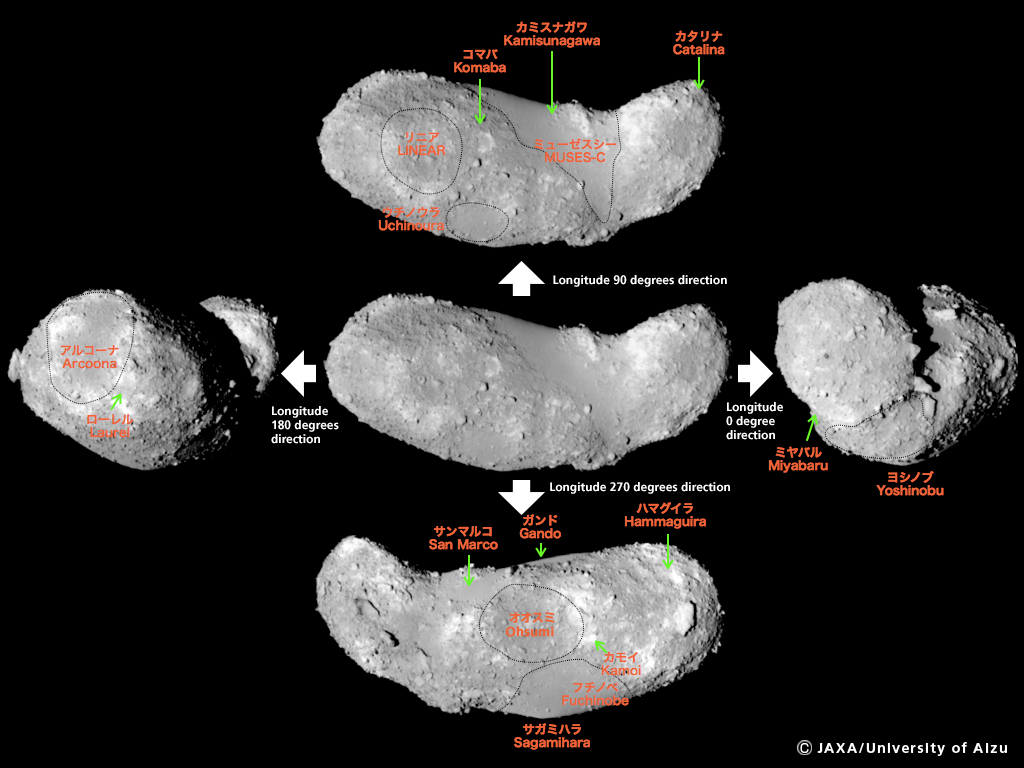
FOTOGRAFIAS DO ITOKAWA CAPTADAS DA NAVE ESPACIAL NÃO-TRIPULADA JAPONESA
HAYABUSA
(Fonte: http://www.jaxa.jp/press/2009/03/20090303_itokawa_e.html)
.jpg)
AMENDOIM COM CASCA, sendo que um deles,
como logo se percebe, aparece semi-descascado
(Só a foto, sem a legenda a cima conferida:
http://stcheraws.blogspot.com/2009_10_01_archive.html)
"Este feito é notável pelo seu ineditismo (alcançar um asteróide com nave-sonda, recolher amostras e trazê-las à Terra) e coloca o Japão na linha de frente da Astronáutica mundial"
(MIGUEL CARQUEIJA, escritor de ficção científica, via e-mail)
Homenageando Suas Majestades o Imperador Akihito (76 anos de idade),
que demonstrou uma atitude pacífica e conciliadora para com os antigos
adversários do Japão - por exemplo, com a Rússia e com a China -, a
Imperatriz Michiko, suas noras e netos,
seus filhos Príncipe Naruhito - que esteve no Brasil, por ocasião das
Comemorações do Centenário da Imigração Japonesa (2008) -,
Príncipe Akishino,
Sra. Sayako Kuroda e seu esposo,
Sr. Yoshiki Kuroda,
em memória de Suas Majestades o Imperador Showa e a
Imperatriz Kojun,
seus ancestrais e seus dignos e leais
SAMURAIS, e, felizmente ainda vivos,
todos os colaboradores da
AGÊNCIA JAPONESA DE EXPLORAÇÃO AEROSPACIAL (JAXA) - incluídos
os senhores empregados de empresas que prestam serviços à JAXA - ,
os astronautas
Frank De Winne, da Agência Espacial Européia, Roman Romanenko, da Agência Espacial da Rússia, Robert Thirsk, da Agência Espacial do Canadá, Koichi Wakata, da JAXA, o comandante russo Gennady Padalka, Mike Barratt, da NASA,
o Tenente-Coronel Marcos Cesar Pontes, da FAB (Brasil),
o artista gráfico Akihiro Ikeshita e
o povo do Japão
17.6.2010 - Os japoneses participam dos esforços pela ampliação dos conhecimentos científicos do universo - Amostras do Itokawa chegaram à Terra em sonda não-tripulada do Japão. A arte da montagem fotográfica HAYABUSA / ITOKAWA (que aparece na matéria jornalística a seguir reproduzida), de imagem da sonda japonesa como se estivesse próxima do asteróide que lembra um amendoim com casca, é de Akihiro Ikeshita. F. A. L. Bittencourt ([email protected])
INFORMOU A JAXA (a "Nasa do Japão"), em 3.3.2009
"Official Approval of Names on ITOKAWA by IAU
March 3, 2009 (JST)
Japan Aerospace Exploration Agency (JAXA)
The Japan Aerospace Exploration Agency (JAXA) requested the International Astronomical Union (IAU) approve 14 names of craters and places on the surface of the asteroid "ITOKAWA," where our Asteroid Explorer "HAYABUSA" carried out scientific observations. The application was submitted under the theme of "place names concerning space development and asteroid science."
On February 19, 2009 (Japan Standard Time,) the names were approved by the IAU, thus they can be used as official names. We thoroughly discussed the names with the IAU's Working Group for Planetary System Nomenclature, and all our proposed names were accepted. This was the first time that Japan requested the approval of such a large number of names for the surface of an asteroid and all of them were accepted at once.
It was also the first time that such a number of Japanese names were christened on the surface of an asteroid.
The names were decided in corporation with the University of Aizu, which studies the topology on the surface of the ITOKAWA based on observation data.

(Reference: Names of astronomical bodies and names of places on astronomical bodies)
Names of astronomical bodies and places on them in the solar system are important information as a basis for discussion among researchers. Therefore, the International Astronomical Union (IAU) functions as the sole organization to manage and administrate the names. When a new name is given, a working group in the IAU carefully examines the application submitted by the discoverer of a new astronomical body or the place on it to study if the name clearly indicates its geographic features, the scientific importance and appropriateness of the reasons for naming. In addition, the group reviews if that name already exists. After a thorough review, the name is approved, and can be officially used. With the approval of the names, further research on the ITOKAWA is expected to progress as we look to share our knowledge about the ITOKAWA with the world.
Table 1: Names on ITOKAWA and where they come from
Crater names
| |
Names |
Originated from |
| 1 |
Catalina |
The name of an astronomical observatory in Arizona, USA. |
| 2 |
Fuchinobe |
A place name in the city of Sagamihara, Kanagawa, Japan. It is also a train station name closest to the JAXA Sagamihara Campus, the center of the HAYABUSA's development and operation. |
| 3 |
Gando |
The name of a rocket launch site in the Canary Islands, Spain. |
| 4 |
Hammaguira |
The name of a French rocket launch site that used to exist in the Sahara Desert (Algeria.) |
| 5 |
Kamisunagawa |
A town name in Sorachi-gun, Hokkaido, Japan, where test equipment for microgravity exists. |
| 6 |
Kamoi |
A place name in the city of Yokohama, Kanagawa, Japan, where a business office of NEC TOSHIBA Space Systems. Ltd., which is a manufacturer of the HAYABUSA, is located. |
| 7 |
Komaba |
A place name in Meguro-ward, Tokyo, Japan, where the former Institute of Space and Astronautical Science of the Ministry of Education was located. |
| 8 |
Laurel |
A city name in Maryland, USA, where the John Hopkins University, Applied Physics Laboratory (APL/JHU) is located. |
| 9 |
Miyabaru |
A place name in Kimotsuki-cho, Kagoshima, Japan, where the radar site of the JAXA Uchinoura Space Center is located. |
| 10 |
San Marco |
An oil mining platform in the Indian Ocean near Kenya. It was used as an Italian rocket launch base in the ocean. |
Place names
| |
Names |
Originated from |
| 11 |
Arcoona Regio |
A place name near the desert in Australia, where the HAYABUSA's capsule will be retrieved. |
| 12 |
LINEAR Regio |
An abbreviation of a project name (Lincoln Near Earth Asteroid Research) at the Lincoln Laboratory, Massachusetts Institute of Technology. They discovered the ITOKAWA. |
| 13 |
Ohsumi Regio |
A peninsular name in Kagoshima, Japan, where the JAXA Uchinoura Space Center is located. |
| 14 |
Yoshinobu Regio |
A place name in Minamitane-cho, Kumage-gun, Kagoshima, Japan, where the launch vehicle range at the JAXA Tanegashima Space Center is located. |
Place names already approved
| |
Names |
Originated from |
| 1 |
MUSES-C Regio |
The mission name of the asteroid explorer HAYABUSA. |
| 2 |
Sagamihara Regio |
A place name in Kanagawa, Japan, where the JAXA Sagamihara Campus is located. |
| 3 |
Uchinoura Regio |
An old town name in Kagoshima where the JAXA Uchinoura Space Center is located. |
The HAYABUSA flying to the ITOKAWA (Artist's Concept)
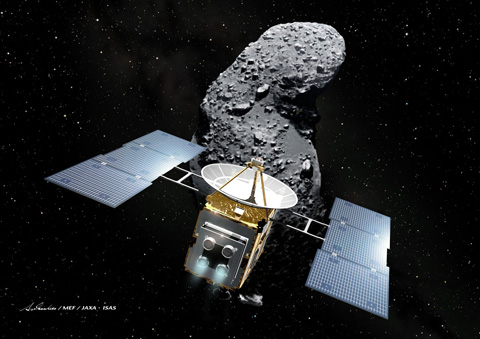
By Akihiro Ikeshita
Names of craters and places on ITOKAWA (Images were taken by the HAYABUSA)
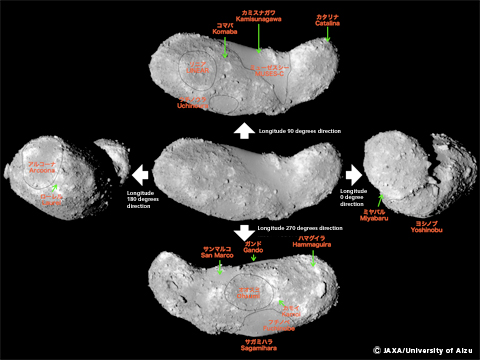
(Reference: Asteroid "ITOKAWA")
The asteroid ITOKAWA (1998 SF36) was discovered by a project called the "Lincoln Near Earth Asteroid Research (LINEAR)" at the Lincoln Laboratory, Massachusetts Institute of Technology, on September 26, 1998. ITOKAWA looks like a sweet potato with a dimension of about 500 meters in length and 300 meters in width. Its rotation period is about 12 hours, and it is an S-type asteroid whose orbit is an elliptical orbit traveling between the Earth's orbit and Mars's orbit with a period of about 1.5 years.
The right to name an asteroid is attributed to its discoverer; however, when the asteroid 1998 SF36 was found, the then Institute of Space and Astronautical Science (current JAXA ISAS) requested the International Astronomical Union (IAU) via the LINEAR to name this asteroid after the late Dr. Hideo Itokawa, the father of rocket development in Japan, as this asteroid was a probe target of the ISAS Asteroid Explorer HAYABUSA. In August 2003, the IAU approved the name "ITOKAWA."
In 2005, the HAYABUSA, whose mission is a sample return from an asteroid for the first time in the world, explored the ITOKAWA. The HAYABUSA is now under operation by JAXA with a target to return to Earth in June 2010.

Mission website:
Asteroid Explorer "Hayabusa"(MUSES-C)".
(http://www.jaxa.jp/press/2009/03/20090303_itokawa_e.html)
===
VERBETE 'HAYABUSA', DA WIKIPÉDIA
A nave espacial Hayabusa (はやぶさ - falcão peregrino) é uma sonda não tripulada gerenciada pela Japan Aerospace Exploration Agency - JAXA, com a finalidade de coletar material de um pequeno asteróide que órbita próximo à Terra denominado de 25143 Itokawa ou simplesmente Itokawa e depois retornar a Terra com as amostras, para análise do material.
A sonda Hayabusa, era anteriormente denominada de MUSES-C (ミューゼスC). Ela foi lançada em 9 de Maio de 2003 e chegou ao asteróide no mês de Setembro de 2005. Ao chegar ao asteróide, a sonda estudou a sua morfologia, rotação, topografia, cor, composição, densidade e a sua história. Em Novembro de 2005 a sonda iniciou preparativos para uma ou duas breves aterrissagens no asteróide para coletar seu material e retornar com as amostra para a Terra em Julho de 2007 (previsão que, devido a imprevistos, foi adiada para Junho de 2010). A sonda também transporta um mini-aterrizador além de um marcador com 880.000 assinaturas que foram coletadas pela The Planetary Society of Japan a fim de deixa-las para sempre no asteróide.
Preâmbulo
Outras sondas como Galileo e NEAR Shoemaker, visitaram anteriormente um asteróide, mas a missão Hayabusa, se obtiver sucesso, deverá ser a primeira sonda a retornar com amostras para a Terra, a fim de serem analisadas.
No dia 20 de Novembro de 2005, a sonda Hayabusa pousou em segurança no asteróide Itokawa e lá permaneceu por cerca de trinta minutos. Apesar do pouso em segurança, a sonda não coletou material do asteróide devido a equívocos na interpretação de sua altitude por parte de seus instrumentos.
A sonda NEAR Shoemaker também efetuou um pouso controlado, sobre a superfície do asteróide 433 Eros em 2000, mas não foi construída para aterrissar e a sonda foi posteriormente desativada. Tecnicamente falando, a Hayabusa não é um aterrizador, mas ela simplesmente tocou a superfície do asteróide e deverá capturar amostras com um instrumento específico. De qualquer maneira foi a primeira sonda a ser projetada para tocar na superfície de um asteróide.
MUSES-C significa “Mu Space Engineering Spacecraft” ; uma nave espacial lançada por um foguete Mu e “C” significa que foi a terceira sonda de sua série, e foi posteriormente denominada de Hayabusa.
O asteróide foi batizado com o nome do primeiro cientista de foguetes do Japão, Hiteo Itokawa.
A Missão
A sonda Hayabusa foi lançada em 9 de Maio de 2003 as 04:29:25 UTC por meio de um foguete M-5 do Uchinoura Space Center, que continua a ser denominado de Kagoshima Space Center. Após o seu Lançamento o nome da sonda foi mudado de MUSES-C para Hayabusa, palavra que em japonês significa falcão. A sonda é equipada com dois motores iônicos de xenônio, cada um com seu próprio exaustor que funcionaram quase que continuamente por quase dois anos. Lentamente movendo a sonda em direção ao asteróide Itokawa, interceptando-o em Setembro de 2005. A sonda não deverá entrar em órbita do asteróide, mas sim manter uma órbita heliocêntrica, próximo ao asteróide.
Hayabusa inicialmente pesquisou o asteróide a uma distancia de 20 km. Depois a sonda se moveu para mais próximo do asteróide, quando deverá efetuar uma série de pousos controlados e deverá coletar amostras do asteróide em dois pontos de sua superfície.
Um sistema autônomo de navegação óptica será empregado devido à demora nas comunicações, tornando-se proibitivo o seu gerenciamento a partir do centro de controle na Terra. Para coletar duas amostras do asteróide, a sonda deverá disparar contra a sua superfície dois pequenos projéteis e coletar os fragmentos que vieram a se despregar. Os fragmentos deverão pesar cada um cerca de uma grama e deverão ser guardados em cápsulas separadas
Depois de alguns meses orbitando próximo ao asteróide, à sonda deverá ligar seus motores e seguirá rumo a Terra. A sonda deverá liberar uma cápsula contendo o material coletado quando ela estiver entre 300.000 a 400.000 km de distancia da Terra. A cápsula deverá seguir uma trajetória balística e reentrar na atmosfera da Terra em Julho de 2007. A cápsula deverá experimentar uma desaceleração de 25 G e um aquecimento pelo menos 30 vezes superior ao experimentado pelas naves do programa espacial Apollo. A cápsula deverá cair na localidade de Woomera, Austrália.
Minerva
Hayabusa transportava uma mini-sonda denominada de MINERVA que é o acrônimo de MIcro/Nano Experimental Robot Vehicle for Asteroid. Pesava apenas 591 gramas e tinha o tamanho de uma máquina de café. Foi feita para ser liberada quando da primeira aproximação da sonda para o pouso no asteróide. Tinha a habilidade de “saltar” sobre a superfície do asteróide e possuía total autonomia. Estava equipada com um sistema de captação de imagens composto por três micro-câmeras e um equipamento de medição de temperatura. Todos os dados coletados seriam enviados para a Hayabusa e esta os enviaria para a Terra.
Lamentavelmente ocorreu um erro durante a fase de seu lançamento e a micro-sonda acabou voando distante do asteróide. Era uma estrutura alimentada por painéis solares, no tamanho de uma caixa de sapatos e foi feita para levar vantagens sobre a baixa força da gravidade do asteróide, pois poderia saltar grandes distâncias ao longo da superfície do asteróide, tirando fotografias e as enviando para a Hayabusa, quando as duas sondas estivessem próximas uma da outra.
A sonda MINERVA foi liberada em 12 de Novembro de 2005. O aterrizador foi liberado a partir de um comando da Terra, mas antes que o comando pudesse chegar a sonda Haybusa, o seu altímetro que media a distância da sonda para Itokawa indicava 44 metros e seus propulsores foram acionados automaticamente para manter a altitude.
Quando o comando chegou, a sonda estava subindo. A análise dos dados no centro de controle sugere que a micro-sonda não teve sucesso em tocar na superfície do asteróide, ao invés disso ele escapou da força de gravidade do asteróide e voou para o espaço.
Caso tivesse tido sucesso, MINERVA deveria ser a primeira sonda a ser vista “caminhando” no espaço. Ao invés disso, ela se juntou ao grupo de sondas “caminhantes” que nunca entraram em ação, como as sondas da missão sovietica Sonda Phobos que também falharam.
A agência especial norte-americana NASA tinha sido originalmente programada que seria ela planejar e construir a pequena micro-sonda , mas o projeto denominado de MUSES-CN ou SSV Rover, foi cancelado em Novembro de 2000, por razões financeiras.
SSV Rover
O veículo, Small Science Vehicle (SSV), seria uma contribuição da NASA para este projeto, mas foi cancelado devido a restrições financeiras.
O SSV deveria ser lançado sobre a superfície de Itokawa. O veículo deveria medir a textura, composição e morfologia do solo do asteróide em escala menor que 1 cm. O veículo deveria pesar cerca de 1 kg e deveria ser capaz de rolar, subir e ou pular sobre a superfície do asteróide. A sonda utilizaria a luz do Sol como fonte de energia e transportaria uma câmera imageadora multi-espectral, um espectrômetro de leitura de radiação próxima ao infravermelho, um espectrômetro de partículas alfas e de raio-X.
Atual estágio da missão
- Dia 20 de Novembro de 2005
- A sonda teve sucesso em pousar no asteróide Itokawa na região denominada mar Muses. Permaneceu sobre sua superfície cerca de 30 minutos. Tal informação só foi confirmada após a leitura de diversos instrumentos, pois havia conflito nos dados inicialmente coletados.
- Apesar de a sonda ter pousado no asteróide, alguns de seus sistemas se equivocaram e a sonda não aproveitou a ocasião para coletar amostras do solo.
- De fato, sensores da sonda detectaram aquecimento em sua estrutura e por este motivo seu sistema automático de navegação a deixou cerca de 100 km de distância do asteróide.
- Pretende-se realizar um novo pouso no asteróide e dentro de algum tempo, será chegada a hora de ele abandonar o asteróide e se dirigir de volta a Terra.
- Dia 28 de Novembro de 2005
- Finalmente a sonda Haybusa conseguiu recolher duas amostras do solo do asteróide.
- No dia 25 de Novembro de 2005, as 10:00 horas da noite no Japão, a sonda iniciou a sua lenta descida de 1 km em direção ao asteróide Itokawa.
- As 6:52 horas da manhã, a sonda reconheceu a marca com 880.000 nomes que havia deixado anteriormente na sua superfície.
- As 6:53 horas da manhã a sonda estava a 35 m de altitude e descia a uma velocidade de 4,5cm/seg.
- As 7:35 horas da manhã os sinais captados pela antena de espaço profundo de Goldstone confirmaram o novo pouso no asteróide.
- As amostras foram recolhidas 1 segundo após o pouso da sonda e foram disparados dois tiros, com um intervalo de 0,2 segundos. Os disparos ocorreram as 7:07 horas da manhã.
- Devido as perda de comunicações previstas quando do pouso sinal e a demora na chegada fos dados e de sua confirmação, existe este hiato entre os acontecimentos e a confirmaçao na sala de controle.
- Dia 12 de Dezembro de 2005
- Devido a uma grande degradação em vários sistemas da sonda, está havendo dificuldades em se manter contacto com a sonda e de também acionar apropriadamente o motor iônico da sonda. A volta da sonda prevista para 2007 foi adiada para Junho de 2010.
Retorna à Terra no território australiano da Woomera após um período de sete anos no espaço marcado por vários problemas.
Ligações externas
 Por Flávio Bittencourt Em: 17/06/2010, às 05H26
Por Flávio Bittencourt Em: 17/06/2010, às 05H26
 (http://projetomaringa.blogspot.com/2008_06_01_archive.html)
(http://projetomaringa.blogspot.com/2008_06_01_archive.html)




.jpg)
![]()

![]()




